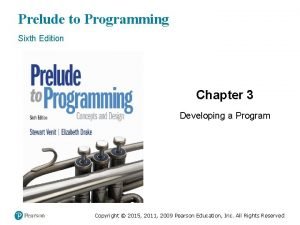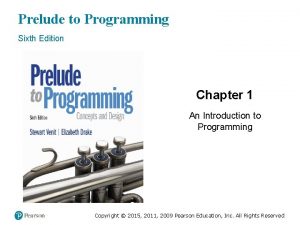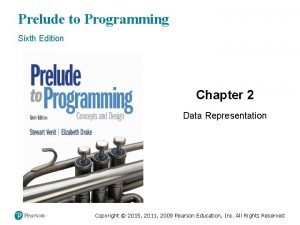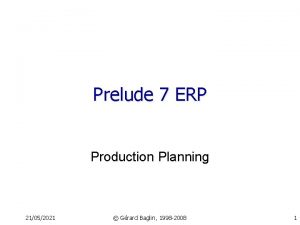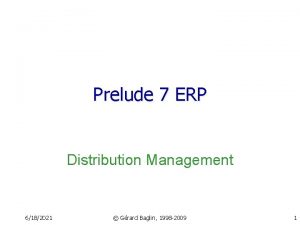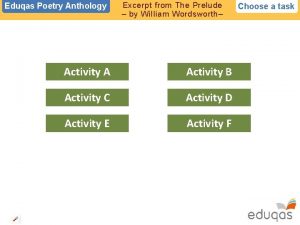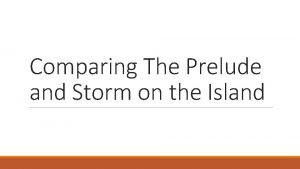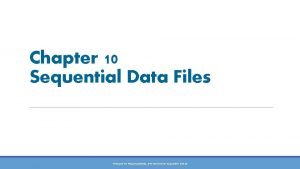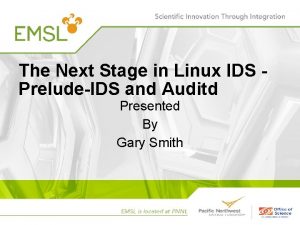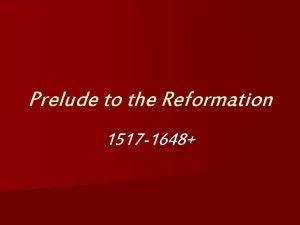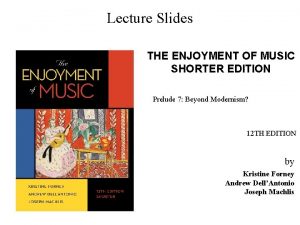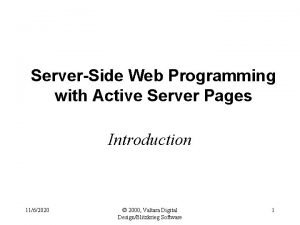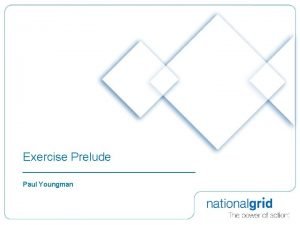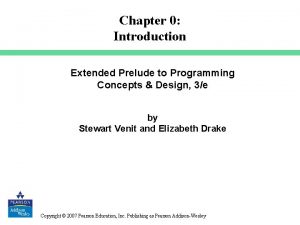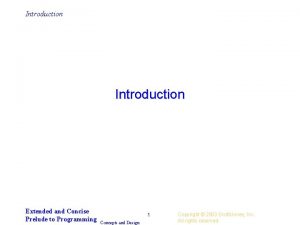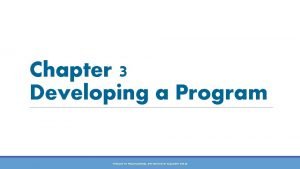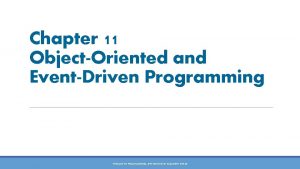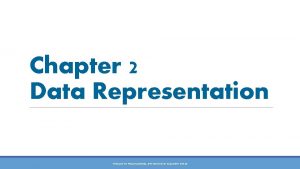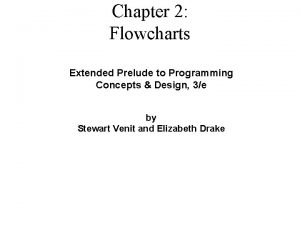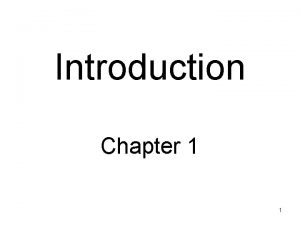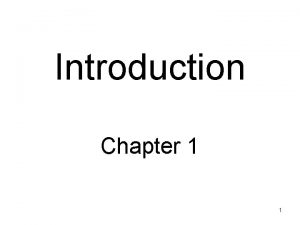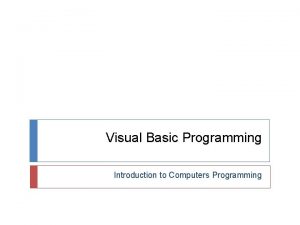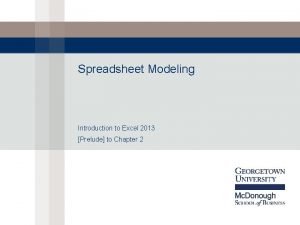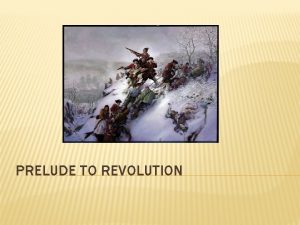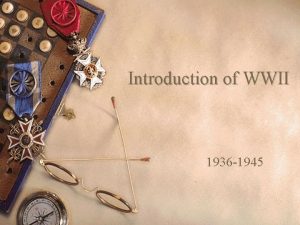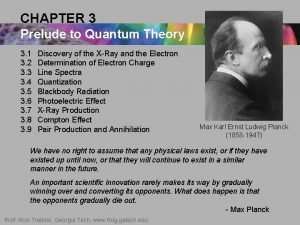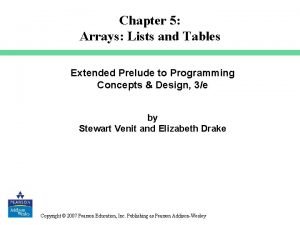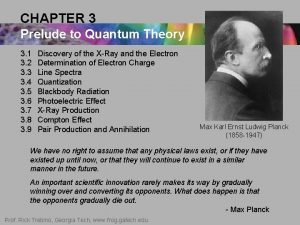Chapter 1 An Introduction to Programming PRELUDE TO




![Java Code for the Music Purchase Program 1. public static void main (String[] args) Java Code for the Music Purchase Program 1. public static void main (String[] args)](https://slidetodoc.com/presentation_image_h/0fe6b4b8456b67708caea132c0a3a66e/image-5.jpg)





























- Slides: 34

Chapter 1 An Introduction to Programming PRELUDE TO PROGRAMMING, 6 TH EDITION BY ELIZABETH DRAKE

1. 1 What is Programming? A program is a list of instructions that is executed by a computer to accomplish a particular task. Creating those instructions is programming. Program development cycle: ◦ Analyze the problem ◦ Design a program to solve the problem ◦ Code the program ◦ Test the program ◦ Revise as necessary PRELUDE TO PROGRAMMING, 6 TH EDITION BY ELIZABETH DRAKE

1. 2 Basic Programming Concepts Important concepts: ◦ Pseudocode is used to plan out the logic of a computer program, using English words and phrases. ◦ Input refers to information that is accepted into the program from the user or other sources. ◦ Variables represent values within a program. ◦ Constants are values used within a program. The value of a constant does not change (i. e. , it is constant) throughout the program. PRELUDE TO PROGRAMMING, 6 TH EDITION BY ELIZABETH DRAKE

Example: The Music Purchase Program Compute the cost of downloading music online. Pseudocode used: ◦ Input the number of songs to purchase, Songs Input Songs ◦ Compute the total cost: Set Dollar. Price = 0. 99 * Songs ◦ Output the total cost: Write Dollar. Price ◦ Variables used: Songs and Dollar. Price ◦ Constants: 0. 99 PRELUDE TO PROGRAMMING, 6 TH EDITION BY ELIZABETH DRAKE
![Java Code for the Music Purchase Program 1 public static void main String args Java Code for the Music Purchase Program 1. public static void main (String[] args)](https://slidetodoc.com/presentation_image_h/0fe6b4b8456b67708caea132c0a3a66e/image-5.jpg)
Java Code for the Music Purchase Program 1. public static void main (String[] args) 2. { 3. int Songs = 0; 4. float Dollar. Price = 0. 0; 5. Scanner scanner = New Scanner(system. in) 6. println(“Enter the number of songs you wish to purchase today. ”); 7. Songs = scanner. next. Int(); 8. Dollar. Price = 0. 99 * Songs; 9. println(Dollar. Price); 10. } PRELUDE TO PROGRAMMING, 6 TH EDITION BY ELIZABETH DRAKE

C++ Code for the Music Purchase Program 1. void main(void) 2. { 3. int Songs; 4. float Dollar. Price; 5. cout << “Enter the number of songs you wish to purchase today. ”; 6. cin >> Songs; 7. Dollar. Price = 0. 99 * Songs; 8. cout << Dollar. Price; 9. return; 10. } PRELUDE TO PROGRAMMING, 6 TH EDITION BY ELIZABETH DRAKE

Data Input operations get data into the programs A user is prompted for the data to be entered ◦ This text uses the word Write to indicate a prompt for input ◦ The word Input indicates that a user has entered a value ◦ Example: Write “Enter the number of songs you wish to purchase today. ” Input Songs ◦ Other types of input can be from a file, dragged by mouse, and more PRELUDE TO PROGRAMMING, 6 TH EDITION BY ELIZABETH DRAKE

Variables and Constants Data is input into a program variable. A variable is a named piece of memory whose value can change during the running of the program. Example: Write “Enter the number of songs you wish to purchase today. ” Input Songs The variable is Songs. A value which cannot change as the program runs is a constant. In this example, the constant is 0. 99. PRELUDE TO PROGRAMMING, 6 TH EDITION BY ELIZABETH DRAKE

Input Prompts A prompt indicates to the user that data should be input. To get the user to enter one number: Write “Enter a number: ” prompts the user to enter a number Input Number stores the number in the variable, Number To get the user to enter two numbers: Write “Enter two numbers: ” Input Number 1 Input Number 2 prompts the user to enter 2 numbers stores the numbers in 2 variables, Number 1 and Number 2 The prompt is the Write statement PRELUDE TO PROGRAMMING, 6 TH EDITION BY ELIZABETH DRAKE

Naming Variables Ø All variable names must be one word Ø Spaces are never allowed Ø Variables cannot begin with a number Ø Names should be meaningful Ø Long names are allowed but names should be as short as possible, yet still be meaningful PRELUDE TO PROGRAMMING, 6 TH EDITION BY ELIZABETH DRAKE

Variable Name Examples Some examples: Miles_traveled is fine Miles Traveled is not (space) Tax. Rate_1 is fine 1_Tax. Rate is not (begins with a number) Variable 1 is fine but not meaningful Z is fine but not meaningful What’s wrong with these? My Number 2_4_6_8_go Cow. Who. Jumped. Over. The. Moon # PRELUDE TO PROGRAMMING, 6 TH EDITION BY ELIZABETH DRAKE

What’s really happening? A variable is the name for a storage location in the computer’s internal memory. The value of a variable is the contents of that location. The contents of the computer’s memory after the Input statement in the Music Purchase program is executed and the user wants to download 78 songs: The Dollar. Price mailbox is empty – it has not yet been assigned a value. At the end of the program, the contents of memory would be: Every time you run the program with a different number of songs, the values in the memory locations will change. The contents of the Songs memory “box” will be replaced by the new number of songs and, after the calculation is made, the contents of the Dollar. Price memory location will be replaced by the new value. PRELUDE TO PROGRAMMING, 6 TH EDITION BY ELIZABETH DRAKE

Try It Suppose a program is to calculate the final (maturity) value of an investment. You will be given the amount invested, the rate of interest, and the length of time that the money is invested. a. What data must be input to this program? b. Give reasonable names for each of the input variables. c. Give Write and Input statements that prompt for and input the data for this problem. PRELUDE TO PROGRAMMING, 6 TH EDITION BY ELIZABETH DRAKE

1. 3 Data Processing and Output Set Dollar. Price = 0. 99 * Songs The above statement is a processing statement. ◦ It means to take the value in the variable Songs, multiply it by 0. 99, and set the value of the variable Dollar. Price to the result of the multiplication. It is also an assignment statement. ◦ It changes the value of the variable Dollar. Price from its previous value to the new value. Write Dollar. Price This output statement will output the value of Dollar. Price to the screen. PRELUDE TO PROGRAMMING, 6 TH EDITION BY ELIZABETH DRAKE

Assigning and Reassigning Values to Variables In a program the following two statements: Set Number. X = 45 Set Number. X = 97 will first assign the value of 45 to the variable, Number. X and then replace that value with 97. After these two statements are executed, Number. X contains the value of 97. The value 45 has been lost. PRELUDE TO PROGRAMMING, 6 TH EDITION BY ELIZABETH DRAKE

Operations on Data: Arithmetic Operations + Addition 2 + 3 = 5 - Subtraction 7 – 3 = 4 * Multiplication 5 * 4 = 20 / Division 12/3 ^ Exponentiation 2^3 % Modulus = 4 = 8 14 % 3 = 2 PRELUDE TO PROGRAMMING, 6 TH EDITION BY ELIZABETH DRAKE

The Modulus Operator The modulus operator returns the remainder after dividing one number by another. 15 % 2 = 1 because 15 ÷ 2 = 7 with a remainder of 1 39 % 4 = 3 because 39 ÷ 4 = 9 with a remainder of 3 21 % 7 = 0 because 21 ÷ 7 = 3 with a remainder of 0 The modulus operator has many uses which are not immediately obvious. For example, to test if a number is odd or even, if X is any integer: If X % 2 = 1, the number is odd If X % 2 = 0, the number is even PRELUDE TO PROGRAMMING, 6 TH EDITION BY ELIZABETH DRAKE

Hierarchy of Operations o First: perform operations inside parentheses (from inside out if more than one) o Second: perform exponentiation o Third: do multiplications, divisions, and modulus from left to right (if there are more than one) o Fourth: do additions and subtractions from left to right (if there are more than one) PRELUDE TO PROGRAMMING, 6 TH EDITION BY ELIZABETH DRAKE

Example of Hierarchy of Operations 3*(6+2)/12+(7– 5)^2*3 = ? 3*6+2/12+(7– 5)^(2*3) = ? ( ) first: = 3*8/12+2^2*3 ( ) first: = 3*6+2/12+2^6 ^ next: = 3*8/12+4*3 ^ next: = 3*6+2/12+64 Leftmost * next: = 24/12+4*3 Leftmost * next: = 18+2/12+64 Division next: = 2+4*3 = 18+. 167+64 Multiply next: = 2+12 Leftmost + next: = 18. 167+64 Addition last: Final + last: = 14 PRELUDE TO PROGRAMMING, 6 TH EDITION BY ELIZABETH DRAKE = 82. 167

Data Output Data that is sent from the program to the screen, printer, or to a file is output. In pseudocode, the following statement will display the value of the variable to the screen and send the cursor to the next line: Write Dollar. Price If Dollar. Price contains the value 9. 90, the output on the screen will be: 9. 90 PRELUDE TO PROGRAMMING, 6 TH EDITION BY ELIZABETH DRAKE

Annotate the Output If the output consists of numbers or any data that has no explanatory text with it, you should annotate your output Annotating output means to add some text so the user knows what the output means. Example: if Test 1 and Test 2 are 2 exam scores for a student: Average = (Test 1 + Test 2)/2 Write “The student’s average is: “ Write Average PRELUDE TO PROGRAMMING, 6 TH EDITION BY ELIZABETH DRAKE

Formatting Output In a program the following two statements: Write “The cost of your purchase is “ Write Dollar. Price will produce the following output: The cost of your purchase is 9. 90 However, the following single statement: Write “The cost of your purchase is ” + Dollar. Price + “ dollars. ” will produce the following output: The cost of your purchase is 9. 90 dollars. Note that the text inside the “ ” is output to the user as is, and it is the value of the variable that is output. PRELUDE TO PROGRAMMING, 6 TH EDITION BY ELIZABETH DRAKE

Formatting Output Be careful to format your output so there appropriate spaces. If Number 1 is a variable with the value of 8, Number 2 is a variable with the value of 6, and Sum is a variable that holds the value of Number 1 + Number 2: The statement: Write “The sum of” + Number 1 + “and” + Number 2 + “is” + Sum will produce the following output: The sum of 8 and 6 is 14 However, the statement: Write “The sum of ” + Number 1 + “ and ” + Number 2 + “ is ” + Sum will produce the following output: The sum of 8 and 6 is 14 PRELUDE TO PROGRAMMING, 6 TH EDITION BY ELIZABETH DRAKE

1. 4 Data Types Each piece of data (a single character, a number, a paragraph, etc. ) is stored in at least one memory location. The amount of space allocated to data initially depends on the data type. Some languages have many data types, such as integer, floating point data, strings, characters, Boolean types, double, and so on. Some languages have only a few data types such as numeric and string. Some languages insist that a data type is declared before it is used and the type can never change. These are called strictly typed languages. Other languages are not as strict about declaring data types and are called loosely typed. We will declare our data types in our pseudocode. PRELUDE TO PROGRAMMING, 6 TH EDITION BY ELIZABETH DRAKE

The Declare Statement Variables should be declared to identify their data type. In this text, a statement such as the following will set aside a space in the computer’s memory to store a variable of a given data type: Declare Variable. Name As Data. Type PRELUDE TO PROGRAMMING, 6 TH EDITION BY ELIZABETH DRAKE

Character and String Data Character data (alphanumerics) ◦ Consists of all the characters you can type at the keyboard ◦ A character string (i. e. , a string) is a sequence of characters. ◦ The data type is String or Character ◦ If a variable is of String or Character type, you cannot perform any math operations on it. ◦ However, you can join two Characters or Strings PRELUDE TO PROGRAMMING, 6 TH EDITION BY ELIZABETH DRAKE

Declaring Character and String Variables The following statement declares a variable named Response to be of Character data type: Declare Response As Character A Character variable can contain only a single character. The following statement declares a variable named User. Name to be of String data type: Declare User. Name As String A String variable can contain as many characters as desired but the whole string of characters must be enclosed within the quotes. ◦ Note that spaces, punctuation, and special symbols such as the %, @, *, and so forth are all considered characters. PRELUDE TO PROGRAMMING, 6 TH EDITION BY ELIZABETH DRAKE

Concatenation If a variable is of String or Character type, you cannot perform any math operations on it. However, you can join (concatenate) two Characters or Strings: ◦ Given: First, Last, and Full are three String variables ◦ Given: First = “Lizzy” and Last = “Duck” ◦ Then the statement Set Full = First + “ “ + Last will assign the value “Lizzy Duck” to Full Note: The space enclosed in quotes is necessary to put a space between the first and last name when stored in the variable Full. PRELUDE TO PROGRAMMING, 6 TH EDITION BY ELIZABETH DRAKE

Integer Data Integers are all the positive, negative, or zero whole numbers Examples: 8 is an integer 8. 3 is not an integer -24, 567, 890 is an integer 4. 0 is not an integer because it has a decimal part PRELUDE TO PROGRAMMING, 6 TH EDITION BY ELIZABETH DRAKE

Declaring Integer Variables Each language has a specific way to declare the data type of its variables. o In this text we use: Declare Variable. Name As Integer o In C++ and Java: int Variable. Name; o In Visual Basic: Dim Variable. Name As Integer o In Java. Script a variable is given a type when it gets initial value. Therefore: var Variable. Name = 0; sets the Java. Script variable to be an integer PRELUDE TO PROGRAMMING, 6 TH EDITION BY ELIZABETH DRAKE

Floating Point Variables PRELUDE TO PROGRAMMING, 6 TH EDITION BY ELIZABETH DRAKE

The Declare Statement Revisited In this text we will declare variables with the following data types: ◦ To declare a variable named Number 1 as a floating point variable use: Declare Number 1 As Float ◦ To declare a variable named Number 2 as an integer variable use: Declare Number 2 As Integer ◦ To declare a variable named One. Letter as a character variable use: Declare One. Letter As Character ◦ To declare a variable named One. Word as a string variable use: Declare One. Word As String PRELUDE TO PROGRAMMING, 6 TH EDITION BY ELIZABETH DRAKE

Naming Conventions Some programmers use specific conventions when naming variables. These are almost always simply a matter of preference. Camel. Back notation examples: Visual Basic convention examples: Declare Number. One As Integer Dim int. Number. One As Integer Declare first. Name As String Dim str. First. Name As String Declare Tax_rate As Float Dim lng. Tax. Rate As Long (Float) PRELUDE TO PROGRAMMING, 6 TH EDITION BY ELIZABETH DRAKE

Boolean Data • Named for George Boole who developed the algebra of logic, basic to the design of digital computer circuits. • A variable of Boolean data type can have only one of two values: true or false. • A 1 represents true and a 0 represents false. • We use the following pseudocode to declare a Boolean variable: Declare Status As Boolean • The uses for Boolean variables will become evident as you continue to write programs. PRELUDE TO PROGRAMMING, 6 TH EDITION BY ELIZABETH DRAKE
 Prelude to programming 6th edition
Prelude to programming 6th edition Prelude to programming 6th edition
Prelude to programming 6th edition Prelude to programming 6th edition
Prelude to programming 6th edition Chapter 1 introduction to computers and programming
Chapter 1 introduction to computers and programming Computer programming chapter 1
Computer programming chapter 1 Chapter 1 introduction to computers and programming
Chapter 1 introduction to computers and programming Chapter 1 introduction to computers and programming
Chapter 1 introduction to computers and programming Perbedaan linear programming dan integer programming
Perbedaan linear programming dan integer programming Greedy vs dynamic programming
Greedy vs dynamic programming What is system programing
What is system programing Integer programming vs linear programming
Integer programming vs linear programming Definisi integer
Definisi integer Kamikaze poem analysis
Kamikaze poem analysis Boat stealing wordsworth
Boat stealing wordsworth Erp production planning
Erp production planning Gérard baglin
Gérard baglin Prelude extract
Prelude extract Extract from the prelude
Extract from the prelude E-prelude.com
E-prelude.com E-prelude.com
E-prelude.com Excerpt from the prelude
Excerpt from the prelude The prelude and storm on the island
The prelude and storm on the island Sequential circuits prelude
Sequential circuits prelude Maurane sur un prélude de bach analyse
Maurane sur un prélude de bach analyse Theauditstream
Theauditstream Prelude to reformation
Prelude to reformation Prelude 7. beyond modernism?
Prelude 7. beyond modernism? Specsavers prelude
Specsavers prelude Optician industry
Optician industry The prelude annotated
The prelude annotated Eprelude
Eprelude E-prelude
E-prelude Introduction to server side programming
Introduction to server side programming Java introduction to problem solving and programming
Java introduction to problem solving and programming Introduction to programming languages
Introduction to programming languages
